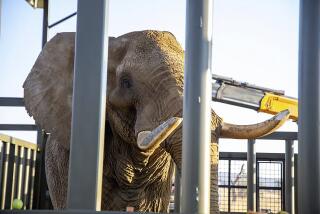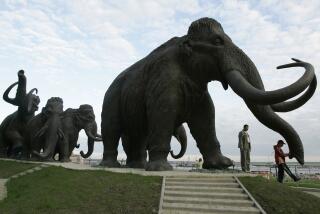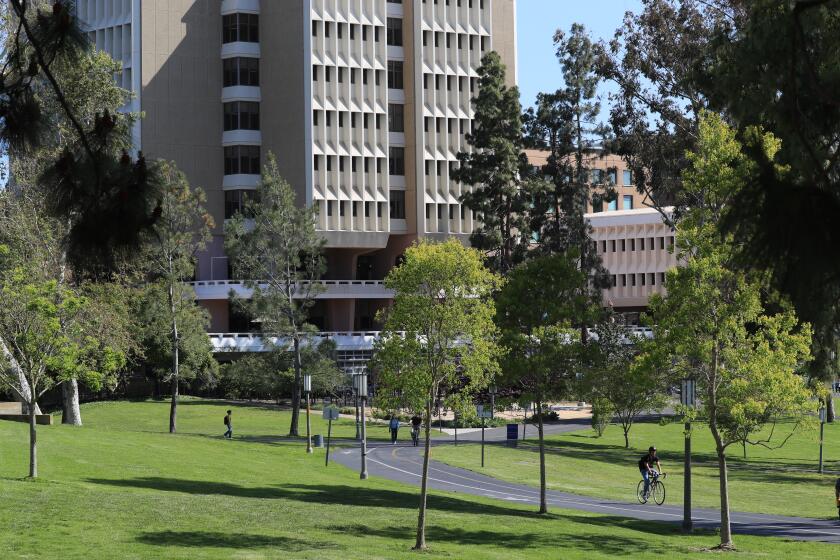A woman and her elephants
- Share via
Cynthia Moss was a young reporter for Newsweek magazine when she took an extended trip to East Africa in 1967 and became enamored of the country. While visiting Lake Manyara National Park in Tanzania, she met British zoologist Iain Douglas-Hamilton, who later founded Save the Elephants, and became his research assistant. In 1972, she founded the Amboseli Elephant Research Project at Amboseli National Park in Kenya and has been working there ever since, studying a herd of about 1,500 elephants. She spoke with The Times on a recent visit to Los Angeles.
Why elephants?
They are so interesting and intelligent and complex, and they have a very interesting social life. They’re long-lived, therefore you can really get your teeth into a study of them.
Are they endangered?
Asian elephants are very endangered. There are only 40,000 of them alive. African elephants, there may be as many as 400,000. But there are estimates that as many as 38,000 elephants are being killed every year by poaching and, with only 400,000 left, they could go extinct in a generation.
The ivory trade is banned by international conventions, but apparently they are not being enforced vigorously.
No. Sadly, it’s the same criminal syndicates that are smuggling all sorts of things. There’s a big demand in China now, where there has never been before. China has been the carver’s site, but [the Chinese] didn’t buy it themselves. Now, with the growing middle class, they want ivory ornaments, jewelry, things like that, and so there is a huge demand.
What’s the Chinese government’s position?
They petitioned to become one of the legal buyers of ivory [from carcasses, confiscated ivory, etc.] and they got that permission the year before last. They’ve definitely encouraged ivory, because they’ve encouraged the ivory factories to open again. And of course, there is not enough [legal] ivory for the carvers. So it’s very unfortunate they were given permission.
Tell me about what you’ve learned about elephants.
We’ve learned that elephants live in very complex societies that are multi-tiered, starting with the family unit that might consist of anything from two to 50 animals, and consists of related females … and their calves. It’s a very stable unit, and the bonds among females are very strong. Certain families have special relationships with certain other families; we call that the bond group. And then there are the clans, which consist of about 10 families. And then there are the subpopulations, which might be 30 families or so, and then the whole population. In Amboseli, we have 57 families.
What about the males?
One of the more interesting things we’ve learned is that males live a totally different life, almost as if they were a different species. They leave the family when they are about 14 years old, shortly after reaching sexual maturity, and then they have a long time before they can compete for mating with females. They go off and spend time with other young males until they grow up some more. A 14-year-old male will be less than half the size of an adult male. So he just bides his time for about 15 years, then he starts being sexually active.
Another of our findings involves this phenomenon known as musth, which the people working with Asian elephants always knew about but thought was a disease or some unfortunate condition with no relevance to anything. But our studies showed that musth also occurs in African elephants and that it is a very important part of their reproductive strategy. [When a male goes into musth,] it’s a complete Jekyll and Hyde transformation. He goes from being a nice placid bull, starts secreting from the glands on the side of his face and starts dribbling urine, which has a very strong smell. He carries his whole body a different way, carries his head high and his chin tucked in, and has a special musth walk and musth vocalization, and he is very, very aggressive. And our studies show that his testosterone levels are four to 10 times [higher] when he is in musth as when he is not in musth. The main usage of musth for a bull is to gain dominance over other bulls so that, if he does find a receptive female, he can mate.
What else?
We’re trying to study cognition, but it is very difficult. The elephants are afraid of certain people who spear them, such as the Masai. The next tribe over is the Akamba, and they don’t spear. [The researchers had a member of each tribe wear a T-shirt for four days.] Then they would put one of these shirts out on the trail in front of the elephants and see what the response was. Inevitably, they would become alarmed if they came upon the Masai shirt, but not if they came upon the Akamba shirt. Also, colors. The Masai wear red, so they tried red and white T-shirts with no smell, and definitely the red shirt elicited an aggressive response.
In another experiment, the researchers would record and play back the call of an adult female. When they played it to the caller’s own family, they would get excited and call “I’m over here!” and they would come toward the speaker. If it was played to members of the caller’s bond group, they would respond in a positive way and call back, but not necessarily come running over like they did with their own family member. Then, if they played the call to members of the same clan … they would get a neutral response, with no calling back. But when they played the call to elephants the female didn’t contact often, they would be alarmed and they would bunch together. In the end, we concluded that a single female knows the calls of at least 100 other females.
What are you doing to preserve the elephants?
Amboseli is an unusual place in that it hasn’t been heavily disturbed by human population pressure. The park is relatively small by African standards, only about 150 square miles, but the ecosystem over which the elephants roam is closer to 5,000 square miles. [The research project tracks the elephants outside the park with radio collars and scouts,] then we provide information on where the crucial areas are, that the elephants have to have. Other organizations, such as the African Wildlife Foundation, have then been doing a lot on setting up easements, corridors and conservancies [to protect the routes].
How can someone here contribute to your work?
In the last two years, it has been very difficult to raise funds, probably because of the economy. We have an annual budget of about $500,000. I employ 26 people, plus there are vehicles and other expenses. You can donate through the website https://www.elephanttrust.org.
More to Read
Sign up for Essential California
The most important California stories and recommendations in your inbox every morning.
You may occasionally receive promotional content from the Los Angeles Times.









